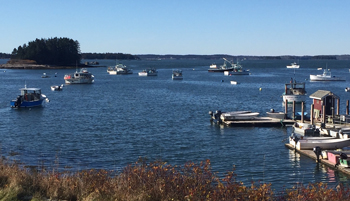Beals Lobsterman Plucked from Icy Water
Continued from January 2020 Homepage

Barney’s Cove, Beals Maine where Anthony Beal went overboard while fishing alone in November. His personal floatation device and the rapid response of fellow fishermen saved Anthony’s life. Nancy Beal photo.
It was windy that day and few had gone to haul early, so it was around 9 a.m. when Beal reached the Sandra Marie. The wind made it hard to get aboard, so he rowed around the stern to try another place on the washboard. “All of a sudden she just sank!” he said in his living room two days later about the small tender he’d used for 20 years. He figured a freak wave washed over the craft and swamped it.
On shore at Barney Cove Lobster, Bucky and Lorena Faulkingham were in their car, trying to decide whether to go to haul in the blow. Bucky remarked that Beal was going out and they watched him get into his skiff and row out to his boat. He disappeared behind the stern, and when the skiff reappeared, it was empty. “He’s in the water!” shrieked Lorena.
Harleigh Alley and his sternman, Joe Reed, were also in the parking lot, mulling over the weather. Lorena ran to their truck, screaming that Beal needed to be rescued. Alley and Reed jumped into a skiff with an outboard motor on the stern, but couldn’t get the motor to start. They tried another outboard whose motor came to life and they sped into the cove to try to find and rescue Beal.
Beal spent a hitch in the Navy, and he knew how to swim. When he found himself overboard, he began treading water, waiting for his PFD to inflate. It was a Mustang fitted with a canister of compressed air and a sensor that automatically causes the vest to inflate when under four inches of water. “C’mon, c’mon, inflate, inflate!” Beal said he kept thinking. Within seconds, the life vest did what it was designed to do and burst into a puffy PFD that kept him afloat.
Then, Beal said, he had to decide where to swim. There is a small island in the cove near his mooring, but he told himself no one would know he was there and feared he’d freeze to death. (He’d lost his phone in the dunking.) Instead, although his mooring is the farthest from the Barney Cove Lobster wharf, he began swimming toward shore. The next thing he knew, he said, Alley and Reed were pulling him into the outboard boat that they had commandeered from the float.
Those on the bank were mustering also. Lorena dialed 911, which activated the local ambulance. Because the Moosabec ambulance was busy, they had to wait for a backup unit from Pleasant River at Columbia, so Lorena went to fetch Beal’s wife, Priscilla “Nini.” By this time, Garet Beal, who manages Barney Cove Lobster for his grandfather, Stanley Beal, came to the scene to help. Lorena said later that the steps that Garet had had built when he took over the buying station “were a godsend” as the crowd helped Beal up from the float to the parking area.
While they were waiting for the ambulance, the neighbors also got involved. Debbie Kelley, who lives on Barney’s Cove, called the Jonesport Coast Guard station, and they promised to stand by, ready if needed. Kelley also enlisted her next-door neighbor, D’Anna Beal, a registered nurse. D’Anna rushed to the scene, pulled Beal’s wet clothes off (Lorena said his jacket “must have weighed 15 pounds”), wrapped him in the dry coats and blankets that were available, and they all waited for the ambulance.
Beal was taken to Down East Community Hospital where he spent the night after water was diagnosed on one lung. “I was never drowning,” he said late last week after returning home, “but my core temperature was so low, if I was able to swim to shore, I might not have had the strength to make it to my truck.” In the ambulance, his temperature was 87 degrees. The Faulkinghams estimated that he had been in the water, hovering at 50 degrees, at least 10 minutes.
Two days later, 72 years and four days old, Beal was home and back to his usual upbeat, loquacious self. In addition to those who saw him go into the water and pulled him out of it, he included his drowned fellow fisherman, Scott Chandler, with helping to save his life because Chandler’s tragedy inspired him to buy and wear the $240 life vest that held him up while others were working to save him. And although he can get the PFD re-packed with more compressed air for $70, he plans to buy a new one—and, likening it to seat belts in a vehicle, encourages all his fellow lobstermen to do the same.
